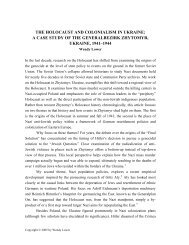Effects of Teachers' Mathematical Knowledge for Teaching on - Apple
Effects of Teachers' Mathematical Knowledge for Teaching on - Apple
Effects of Teachers' Mathematical Knowledge for Teaching on - Apple
You also want an ePaper? Increase the reach of your titles
YUMPU automatically turns print PDFs into web optimized ePapers that Google loves.
Hill, Rowan, & Ball<br />
resentative sample <str<strong>on</strong>g>of</str<strong>on</strong>g> kindergarten students participating in the Early Childhood<br />
L<strong>on</strong>gitudinal Study. 3 This table indicates that the kindergarten sample<br />
in our study differed <strong>on</strong>ly slightly from the nati<strong>on</strong>ally representative sample<br />
<str<strong>on</strong>g>of</str<strong>on</strong>g> kindergarten students, str<strong>on</strong>gly suggesting that our sample included a sufficient<br />
range <str<strong>on</strong>g>of</str<strong>on</strong>g> children, schools, and educati<strong>on</strong>al c<strong>on</strong>texts to allow reas<strong>on</strong>able<br />
statements about the c<strong>on</strong>tributi<strong>on</strong> <str<strong>on</strong>g>of</str<strong>on</strong>g> teachers’ knowledge to student<br />
achievement. In particular, there is little indicati<strong>on</strong> that student variables in<br />
our sample were truncated in ways that would limit statistical inferences or<br />
the ability to generalize our findings to a larger populati<strong>on</strong> <str<strong>on</strong>g>of</str<strong>on</strong>g> schools and<br />
students. Our final sample <str<strong>on</strong>g>of</str<strong>on</strong>g> students included 1,190 first graders and 1,773<br />
third graders.<br />
Just as students in the sample were from varied social backgrounds,<br />
schools in the sample were situated in many different policy and social envir<strong>on</strong>ments.<br />
For example, these schools were located in 42 districts in 15 states.<br />
States varied in size, in average Nati<strong>on</strong>al Assessment <str<strong>on</strong>g>of</str<strong>on</strong>g> Educati<strong>on</strong>al Progress<br />
scores, and in approaches to improving low-per<str<strong>on</strong>g>for</str<strong>on</strong>g>ming schools. While<br />
3 states were scored as being am<strong>on</strong>g the least “interventi<strong>on</strong>ist” <strong>on</strong> Carnoy and<br />
Loeb’s (2002) accountability index, another 4 states scored at the top <str<strong>on</strong>g>of</str<strong>on</strong>g> this<br />
scale, indicating that they were pursuing str<strong>on</strong>g state-level rewards and sancti<strong>on</strong>s<br />
to improve schools and student per<str<strong>on</strong>g>for</str<strong>on</strong>g>mance. The remaining 8 states<br />
clustered near the less interventi<strong>on</strong>ist end <str<strong>on</strong>g>of</str<strong>on</strong>g> the scale. In <strong>on</strong>e state and several<br />
districts, participati<strong>on</strong> in comprehensive school re<str<strong>on</strong>g>for</str<strong>on</strong>g>m was mandatory<br />
<str<strong>on</strong>g>for</str<strong>on</strong>g> schools per<str<strong>on</strong>g>for</str<strong>on</strong>g>ming below a certain level; in other states and districts, comprehensive<br />
school re<str<strong>on</strong>g>for</str<strong>on</strong>g>ms were entirely opti<strong>on</strong>al.<br />
The teacher sample <str<strong>on</strong>g>for</str<strong>on</strong>g> this study comprised 334 first-grade and 365 thirdgrade<br />
teachers. These teachers were fairly typical <str<strong>on</strong>g>of</str<strong>on</strong>g> the elementary teaching<br />
<str<strong>on</strong>g>for</str<strong>on</strong>g>ce, particularly in urban schools. Eighty-six percent <str<strong>on</strong>g>of</str<strong>on</strong>g> the teachers were<br />
female; 55% were White, 23% were Black, and 9% were Hispanic. Approximately<br />
90% <str<strong>on</strong>g>of</str<strong>on</strong>g> the teachers were fully certified, and the average teacher in the<br />
sample had just over 12 years <str<strong>on</strong>g>of</str<strong>on</strong>g> teaching experience.<br />
Data Collecti<strong>on</strong> Instruments<br />
Data collecti<strong>on</strong> centered <strong>on</strong> two cohorts <str<strong>on</strong>g>of</str<strong>on</strong>g> students, <strong>on</strong>e that entered the study<br />
in kindergarten and was followed through sec<strong>on</strong>d grade and another that<br />
entered the study in third grade and was followed to the end <str<strong>on</strong>g>of</str<strong>on</strong>g> fifth grade. In<br />
the case <str<strong>on</strong>g>of</str<strong>on</strong>g> each cohort, data were collected in two waves: In 2000–2001, in<str<strong>on</strong>g>for</str<strong>on</strong>g>mati<strong>on</strong><br />
was collected <strong>on</strong> first and third graders in 53 schools; in 2001–2002,<br />
in<str<strong>on</strong>g>for</str<strong>on</strong>g>mati<strong>on</strong> was collected <strong>on</strong> an additi<strong>on</strong>al 62 schools. These two waves <str<strong>on</strong>g>of</str<strong>on</strong>g><br />
data collecti<strong>on</strong> were collapsed in the present analyses. In the remainder <str<strong>on</strong>g>of</str<strong>on</strong>g> this<br />
article, we discuss the data <strong>on</strong> first- and third-grade students collected according<br />
to this design, reporting instrument resp<strong>on</strong>se rates separately <str<strong>on</strong>g>for</str<strong>on</strong>g> the two<br />
waves <str<strong>on</strong>g>of</str<strong>on</strong>g> data collecti<strong>on</strong>.<br />
A variety <str<strong>on</strong>g>of</str<strong>on</strong>g> survey instruments were used in collecting data. Data <strong>on</strong><br />
students, <str<strong>on</strong>g>for</str<strong>on</strong>g> example, were derived from two major sources: student assessments<br />
and parent interviews. Student assessments were administered in the<br />
380




